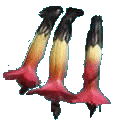The Legend of Kantuta
Version rewritten by N. Brachet, based on the book "Leyendas de mi tierra"
of Antonio Diaz Villamil
(Libreria - Editorial "Juventud")
A long time ago, were two rich and powerful kings, Illampu and Illimani, reigning as absolute Masters, the first on the arid northern regions, the second in the the fertile valleys of Yungas. The two kingdoms lived peacefully in happiness and great harmony. The two kings had each one a son who had the same age and whose birth had been accompanied by the appearance in the sky of two brilliant stars, one of red color the other of gilded color. Illampu and Illimani used the opportunity of this natural phenomenon for naming their son respectively Red Star, and Gilded Ray. The birth of kings Illampu and Illimani had also been, at their time, marked by the appearance in the sky of two bright stars of white color.
Each evening, the two kings contemplated with pride the splendor of their own star. Those of their son scintillated more slightly on the side. The glare of royal stars grew each day a little more as the conquests and richness of the two kingdoms accumulated.
The years passed, the pride of the two kings grew, like their concern in front of the brightness of star of their rival. A feeling of jealousy invaded them little by little, and it was Illampu which yielded the first to its desire to put an end to the provocative glare of rival star. The council of the Wise recommended to him to carry out a war against Illimani, in order to eliminate the sovereign from the throne and consequently, to extinguish his star forever. Illampu followed the advice of the Wise and declared the war against Illimani.
The battle was terrible. All the men formerly so peaceful started to kill each other. Illampu and Illimani came face to face for a final combat, and fought without pity until both got deadly wounded. The two armies withdrew to their capital city. Laying on their bed of death, the two kings requested to talk to their son, and asked them to swear to avenge their death by resuming the war against the rival kingdom. Red star and Gilded Ray, in spite of their constant opposition to the war, had of another choice only to accept the last will of their father. Thus the war began again between the two kingdoms.
The history repeated itself with the same violent combats, ending with the mortal confrontation of Red Star and Gilded Ray. In the last moments of their life, the two young princes did not show any sign of hatred nor of rancor towards their enemy. On the contrary, their last gestures were to embrace themselves. This noble attitude immediately triggered peace and friendship among all the warriors. At this moment, the ground started to shake, and the Pachamama goddess spouts out of the Earth. She directed her speech to Red Star and Gilded Ray to greet their love and their courage and to denounce the heinous and conceited behavior of their fathers. She pointed out the white stars of Illimani and Illampu which at once faded and were projected to the ground in their capital city. They were then transformed into two enormous inert and opaque masses, standing in the medium of the Andes. Pachamama announced to Red Star and gilded Ray that their fraternal union will give birth to one peaceful civilization whose representative colors would be red and yellow combined with green color which is a symbol for hope. Red Star and Gilded Ray died shortly after and were buried together in the valley where the battle took place.
 After many years, the competition between Illampu and Illimani
had not calmed down. But the two mounts immobile for eternity were condemned to contemplate and ruminate their rage and hatred.
Their tears of anger and despair ran out along their flanks and reached the valley where Red Star and Gilded Ray were buried. In
contact with the water, miraculously germinated a a green, yellow and red kantuta, flower on the
tomb of the young princes. A few centuries later, as announced by Pachamama goddess, the Bolivian civilization appeared, which
selected for emblem the kantuta flower and its three main colors.
After many years, the competition between Illampu and Illimani
had not calmed down. But the two mounts immobile for eternity were condemned to contemplate and ruminate their rage and hatred.
Their tears of anger and despair ran out along their flanks and reached the valley where Red Star and Gilded Ray were buried. In
contact with the water, miraculously germinated a a green, yellow and red kantuta, flower on the
tomb of the young princes. A few centuries later, as announced by Pachamama goddess, the Bolivian civilization appeared, which
selected for emblem the kantuta flower and its three main colors.